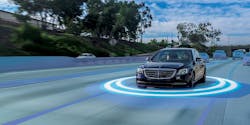Self-Driving Car Legislation Will Try Again Next Year
Engineers, generally speaking, don’t like surprises, unexplained phenomenon, or any changes after design details have been nailed down. They also don’t like bureaucracy and political red tape.
So, it’s perhaps needless to say that no one was happy with the fact that this year, again, legislation did not pass the most recent Congress. This was due to disagreements on the extent to which Congress should alter the traditional division of vehicle regulation, with the federal government being responsible for vehicle safety and states for driver-related aspects such as licensing and registration.
The latest attempt was introduced when Republican Representative Bob Latta reintroduced legislation on self-driving car reforms. “Congress must act to create a national framework that provides developers certainty and a clear path to deployment,” said Latta.
Representative Debbie Dingell, a Michigan Democrat, said that although she agreed “urgent action” is needed and received commitment from key Democratic leaders, added that Latta’s bill would not be approved this year. Autonomous-vehicle legislation will be a priority and legislators will work to move it early in the new year through the Energy and Commerce Committee, she said.
On a state level, in Hawaii, an autonomous-vehicle testing pilot program within the State’s Department of Transportation (HDOT) now allows the program to test autonomous vehicles on any public road in the state. A human driver must be present in the vehicle to intervene, prevent a collision, or resolve any other issues during testing.
One of the major projects related to the future of autonomous vehicles in the state was announced by UH Mānoa, HDOT, and the Federal Highway Administration. Along the Nimitz Highway and Ala Moana Boulevard is a corridor that uses “vehicle-to-everything” (V2X) communication technology, connecting vehicles, pedestrians, and bicyclists to the infrastructure.
Other benefits of autonomous-vehicle technology include less traffic, reduced travel times, extending mobility options to people with disabilities, lower fuel consumption, and decreased carbon-dioxide emissions.
Over in Europe…
In Europe, Mercedes-Benz announced that the company intends to include level 3 autonomous-driving technologies in the new 2021 S class. It will feature adaptive cruise control with lane centering and automatic lane-change capabilities; level 3 technology will be added at a later date.
Level 3 autonomy means that the car is equipped to allow drivers to take their hands off the wheel for an extended period. Mercedes says the technology will allow drivers to be able to hand over control to the car at speeds of up to 60 kmh. Initially, Drive Pilot will be available only in Germany, though not until the second half of 2021 when regulatory approval is completed.
In the U.K., industry experts and insurers have warned the government against allowing automated lane-changing technology on public roads. Thatcham Research and the Association of British Insurers (ABI) are urging the government to revise plans to introduce automated lane-keeping systems (ALKS) onto U.K. roads in early 2021, suggesting regulators should undertake further work with interested parties to ensure road safety is fully considered before introducing the technology.
The experts believe that neither the technology nor the existing transport regulations allow for levels of control afforded by a competent and engaged human driver and aren’t safe enough to be classified as “Automated Driving.”
Thatcham says it has serious safety concerns about this plan because ALKS are largely based on today’s assisted-driving technology scenarios, such as debris on the carriageway, pedestrian encroachment, and highway lane closure.
Tests showed sensors within today’s assisted-driving technology can only interpret up to around 120 meters (131 yards). At motorway speeds, that distance allows only four seconds to take back control and avoid an incident. Current studies suggest a driver needs more than 15 seconds to properly engage and react appropriately to a hazard. That’s 500 meters (546 yards) more required distance than provided by today’s technology.

